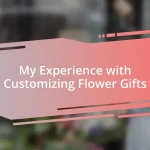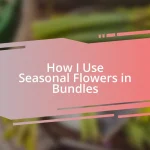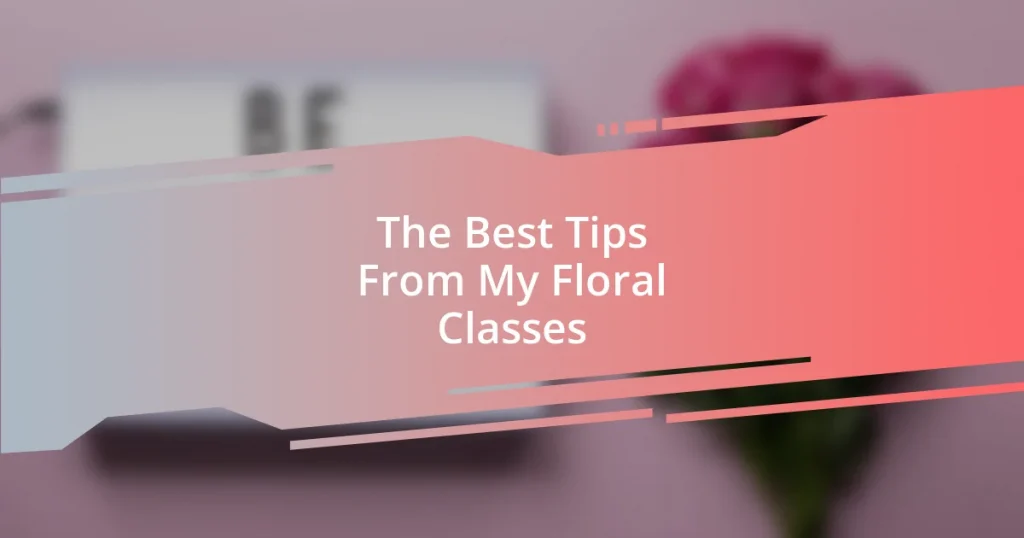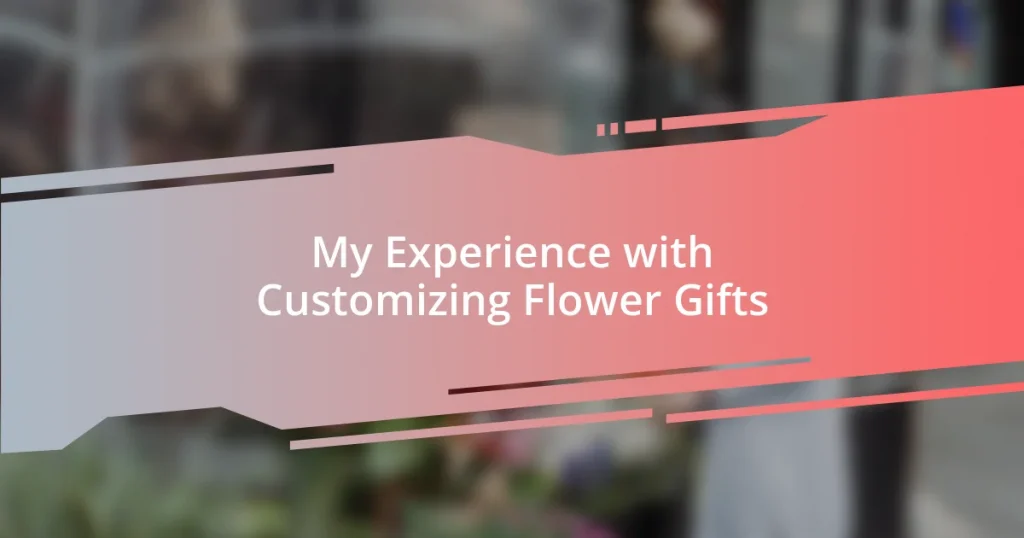Key takeaways:
- Floral classes foster creativity, community, and practical skills that elevate flower arranging from a hobby to a potential career.
- Understanding design principles such as color theory, aesthetics, and the use of focal points enhances the visual impact of floral arrangements.
- Choosing compatible flowers, embracing seasonal varieties, and utilizing unique containers can significantly elevate the art of floral composition.
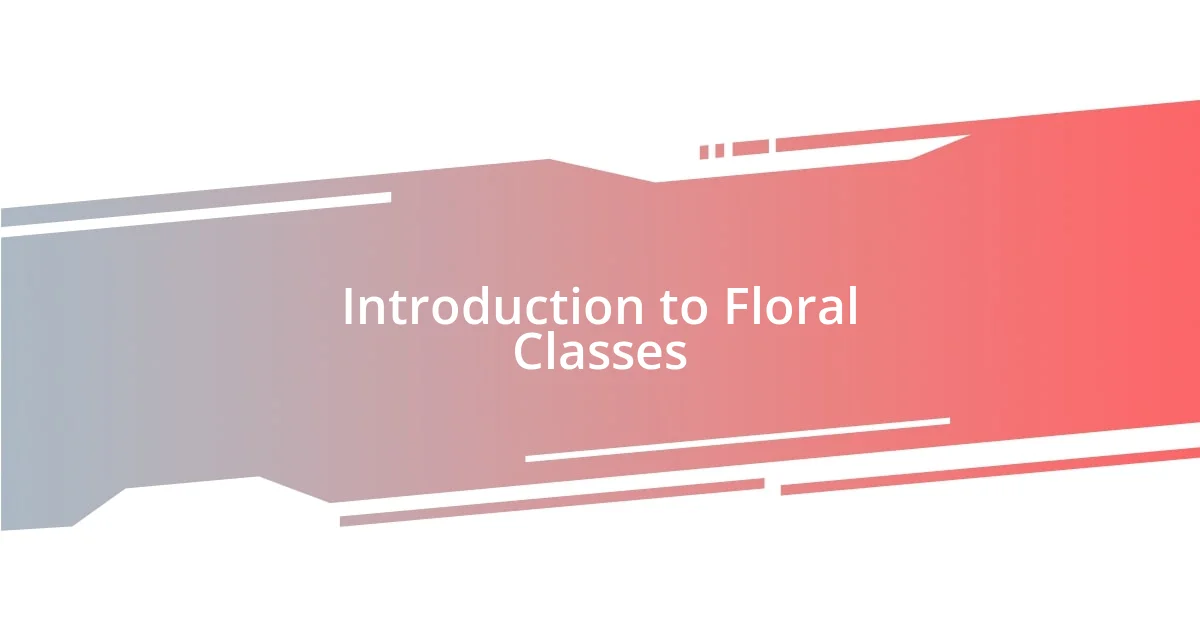
Introduction to Floral Classes
Floral classes offer a unique opportunity to dive into the art of flower arrangement while connecting with nature in a hands-on way. I remember my first class vividly; the intoxicating scent of fresh blooms filled the air, and as I fumbled with my first arrangement, I wondered, “Can I really create something beautiful?” Spoiler alert: I did, and it was exhilarating!
One of the most rewarding aspects of these classes is the community that forms among participants. I’ve made friends while getting my hands a little dirty with soil and petals, all united by a love for flowers. Have you ever experienced that moment of collective achievement, where everyone steps back to admire their creations? It’s truly special and creates bonds that last beyond the class.
These sessions aren’t just about learning techniques; they’re also about tapping into your creativity and expressing yourself. I’ve discovered that picking the right flowers and combining colors can be incredibly therapeutic. Have you felt that rush of joy when you nail a challenging arrangement? It’s those little victories that keep me coming back for more, eager to explore the next level of floral artistry.
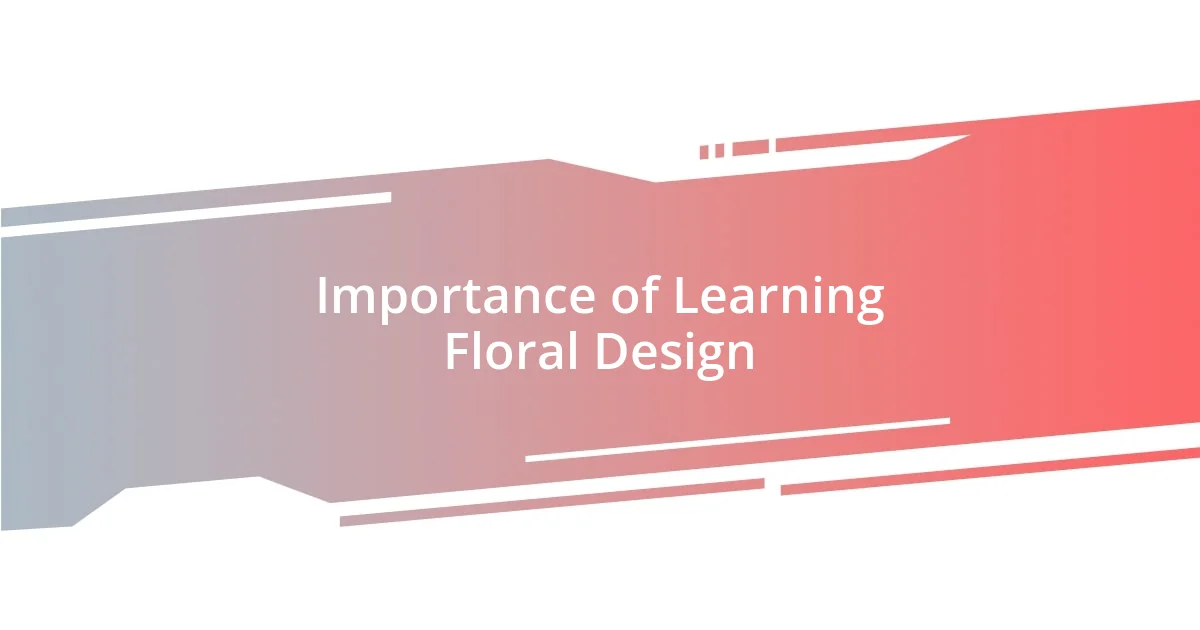
Importance of Learning Floral Design
Floral design is more than just arranging flowers; it’s about understanding the principles of aesthetics and how they can transform a space. From my experience, knowing the elements of design—like balance, contrast, and harmony—can elevate your arrangements beyond mere decoration. Each class I took reinforced how much thought goes into creating a beautiful display, and every time I delved into those concepts, I felt another layer of my creativity unfold.
When I first learned about color theory in floral design, it blew my mind. I had always thought flowers just looked great together, but there’s a science behind it. Understanding how different hues interact can make or break an arrangement. I recall a moment when I chose complementary colors for my first large display. The response from my classmates was overwhelming, and that affirmation filled me with pride and excitement. Have you ever had a moment where your creativity is validated? Those experiences are invaluable.
Moreover, learning floral design gives you practical skills that can lead to professional opportunities. I remember sharing my newfound knowledge with friends and family, and they were impressed. Whether it’s creating arrangements for events or decor, the skills I gained have proven beneficial in various aspects of my life. Floral design can also increase one’s attention to detail, something I find helpful in everyday tasks.
| Aspect | Traditional View | Floral Design Insight |
|---|---|---|
| Aesthetic Principles | Just arranging flowers | Understanding balance and harmony |
| Color Theory | Choosing flowers randomly | Utilizing complementary colors for impact |
| Skill Application | Hobby only | Possible career opportunities |
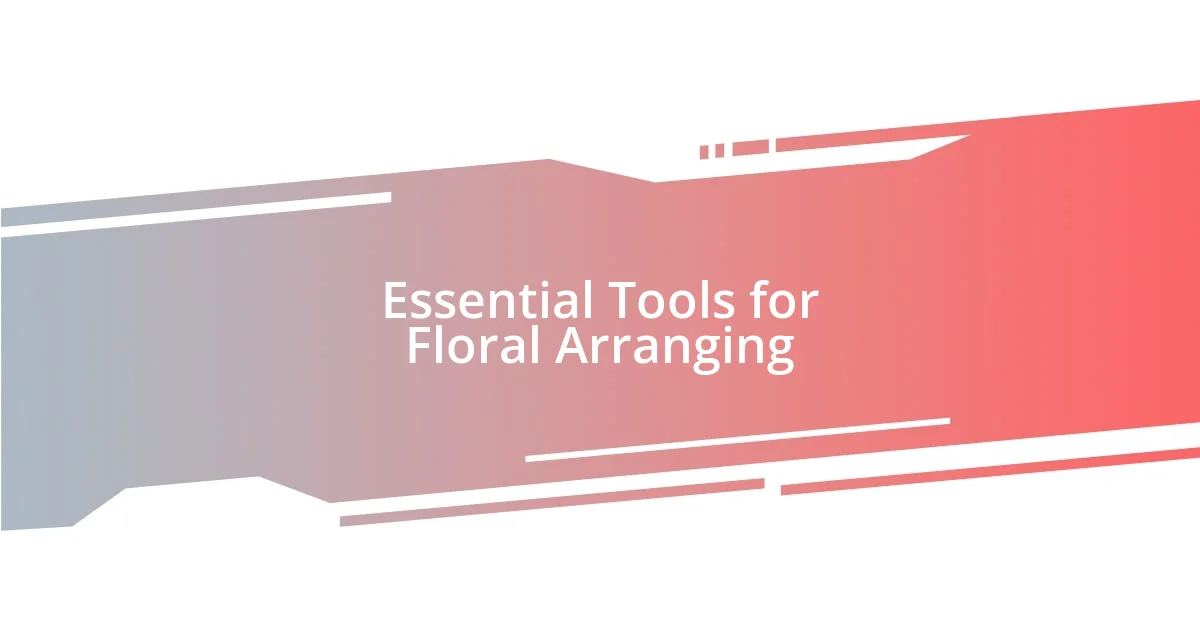
Essential Tools for Floral Arranging
In floral arranging, having the right tools can make all the difference. I remember my first class when I saw the instructor effortlessly snipping stems and shaping arrangements with precision. It struck me just how crucial the right equipment is for achieving both beauty and efficiency. Here are some essential tools I’ve come to rely on:
- Floral shears: Sharp and easy to handle, these are vital for cutting stems cleanly.
- Floral tape: Perfect for securing stems together and creating structure in your arrangements.
- Wire cutters: They make trimming thicker stems and wires a breeze.
- Vases or containers: The right vessel elevates your floral display and contributes to the overall composition.
- Floral foam: This keeps your flowers in place and ensures they drink water.
- Pruning scissors: Great for finesse trimming and quick snips during the design process.
- Greenery: Not technically a tool, but the right foliage can add texture and contrast to your arrangements.
As I began building my toolkit, I became more confident and creative in my designs. One day, during an exercise with some stubborn stems that just wouldn’t sit right, I was amazed at how a simple pair of floral shears transformed my struggle. With one clean cut, the whole look changed, and I felt a rush of creativity flow. There’s something almost magical about discovering that the right tools unlock possibilities; it’s like painting with a full palette instead of just a few colors.
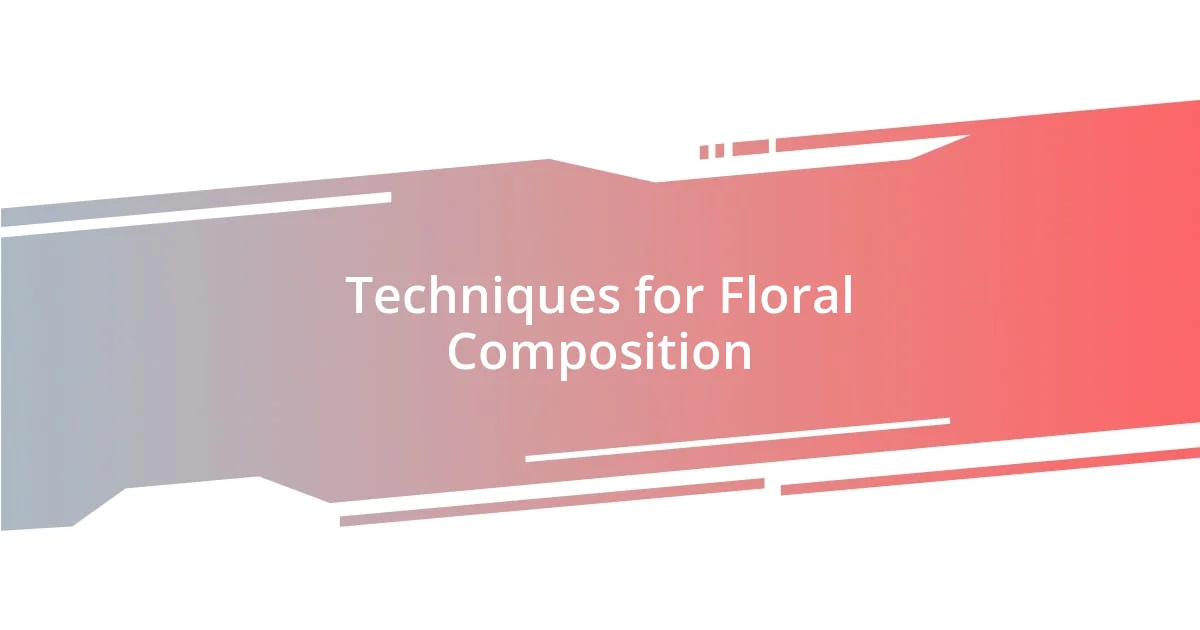
Techniques for Floral Composition
When it comes to floral composition, the techniques I’ve learned emphasize the importance of structure and shape. I remember my instructor demonstrating the spiral technique, which involves arranging flowers in a twisting pattern that adds depth and movement. This technique not only looks stunning but also helps to create a balanced form. Have you ever seen a bouquet that seemed to dance in the vase? That’s the magic of employing the right techniques.
One of my favorite techniques is the use of focal points. It’s like telling a story with flowers, where one bold bloom takes center stage. During one of my classes, I chose a striking peony as my focal point, and the joy I felt when my classmates noticed it was incredible. It made me realize how a single element can draw the eye and create a strong narrative in an arrangement. This insight has stayed with me, reminding me that simplicity can often speak volumes.
Layering different textures can also elevate a floral composition significantly. I’ve found that mixing delicate blossoms with sturdy branches creates an intriguing contrast. For instance, I once paired soft dahlias with rugged eucalyptus, and the outcome was breathtaking. It taught me not only to appreciate the beauty of individual elements but also to embrace the harmonious chaos they can create together. Isn’t it fascinating how combining different components can yield something entirely new and beautiful? Each technique I’ve adopted serves as a brushstroke on the canvas of floral art, shaping a distinct expression.
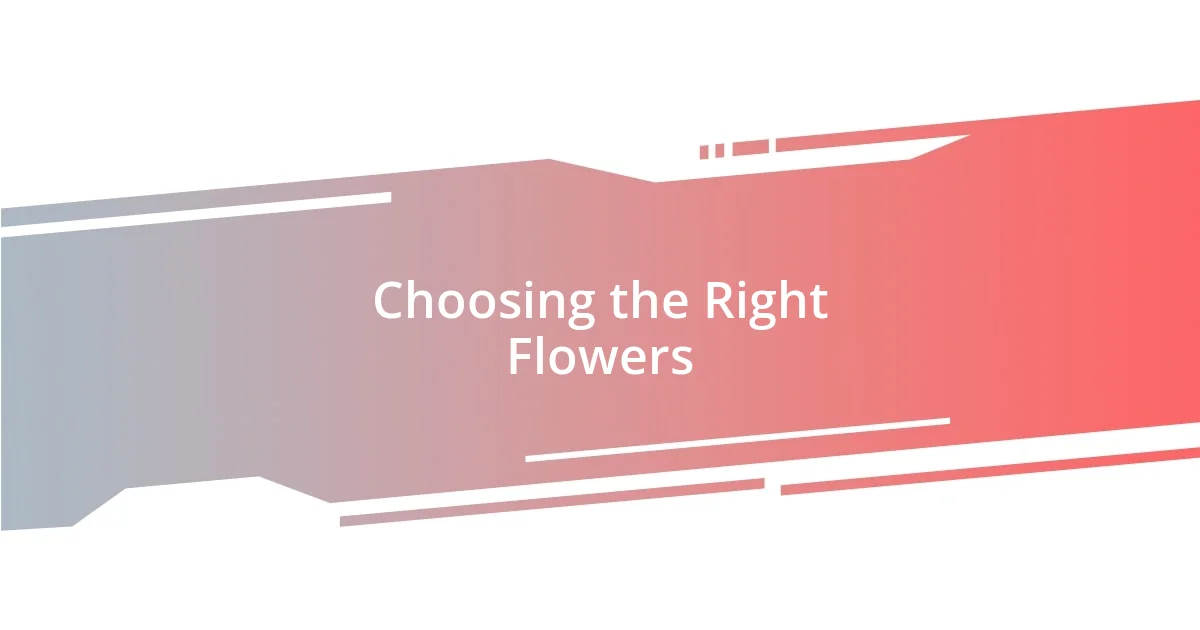
Choosing the Right Flowers
Choosing the right flowers is essential in creating a visually captivating arrangement. I still remember the first time I walked into a flower market, completely overwhelmed by the riot of colors and textures. At that moment, I understood that the flowers I selected would set the tone for my entire arrangement. It’s not just about aesthetics; each flower has its own personality and contributes to the overall mood you wish to evoke. Have you considered how a sunny yellow daffodil can brighten someone’s day, while a deep red rose might convey something more passionate?
When selecting flowers, I always consider their longevity and how they interact with one another. Some blooms can thrive together, while others might clash or wilt too quickly. I once paired hydrangeas, known for their lush fullness, with delicate sweet peas in a showcase arrangement. As beautiful as it looked, I quickly noticed that the sweet peas couldn’t keep up with the hydrangeas’ robust nature, and they faded within a day. This taught me to always think about compatibility, just like you would when creating a balanced team; not everyone is meant to work together!
Don’t shy away from exploring seasonal flowers, as they often have a freshness and vitality that can elevate your designs. I’ll never forget the thrill of an autumn class where we focused on using seasonal blooms. The vibrant oranges and reds of autumn leaves, combined with rustic sunflowers, created a lively, warm atmosphere. It reminded me that nature’s calendar offers a unique palette, encouraging us to tap into what’s available around us. So, what will you choose for your next arrangement? Embrace the season, the moment, and let your creativity flourish!
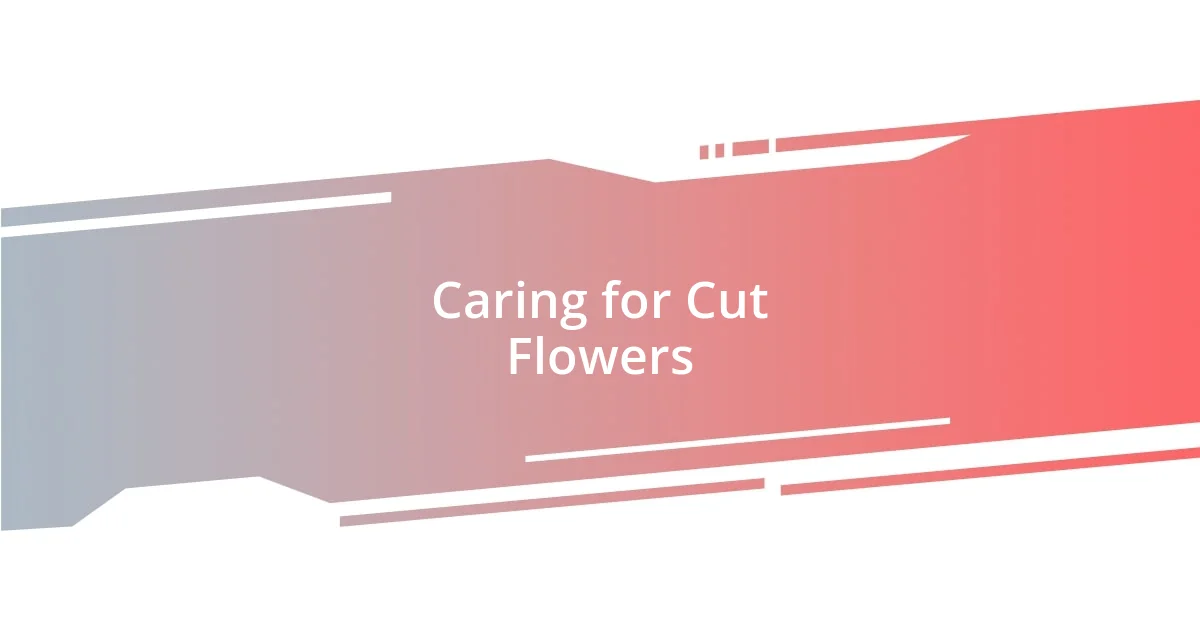
Caring for Cut Flowers
When it comes to caring for cut flowers, I’ve found that the initial handling is crucial. After harvesting or purchasing your blooms, it’s vital to give them a fresh cut at an angle. This simple step maximizes their water intake. I remember the first time I forgot to do this—I was excited to arrange my flowers, but they wilted quickly. Have you ever felt that pang of disappointment when your carefully chosen stems don’t last as long as you hoped?
Another essential aspect is the temperature and environment where you place your flowers. Keeping them in a cool room and away from direct sunlight can make a noticeable difference in their lifespan. I once showcased a stunning bouquet at an outdoor event, but the sun was relentless. The rapid wilting of my beautiful blooms was disheartening, and it taught me to always consider their preferred environment. I now ask myself, “Is this a happy space for my flowers?”
Additionally, regularly changing the water and adding flower food can breathe life back into faded arrangements. I can’t tell you how many times I’ve noticed a bouquet perk up merely by refreshing the water. I once experimented with homemade flower food made of sugar and lemon—what a game changer! Seeing those flowers bloom healthily reminded me of the small gestures that can produce significant results. So, what little steps will you take to ensure your flowers flourish? Embrace the care they need, and you’ll be rewarded with days of beauty.
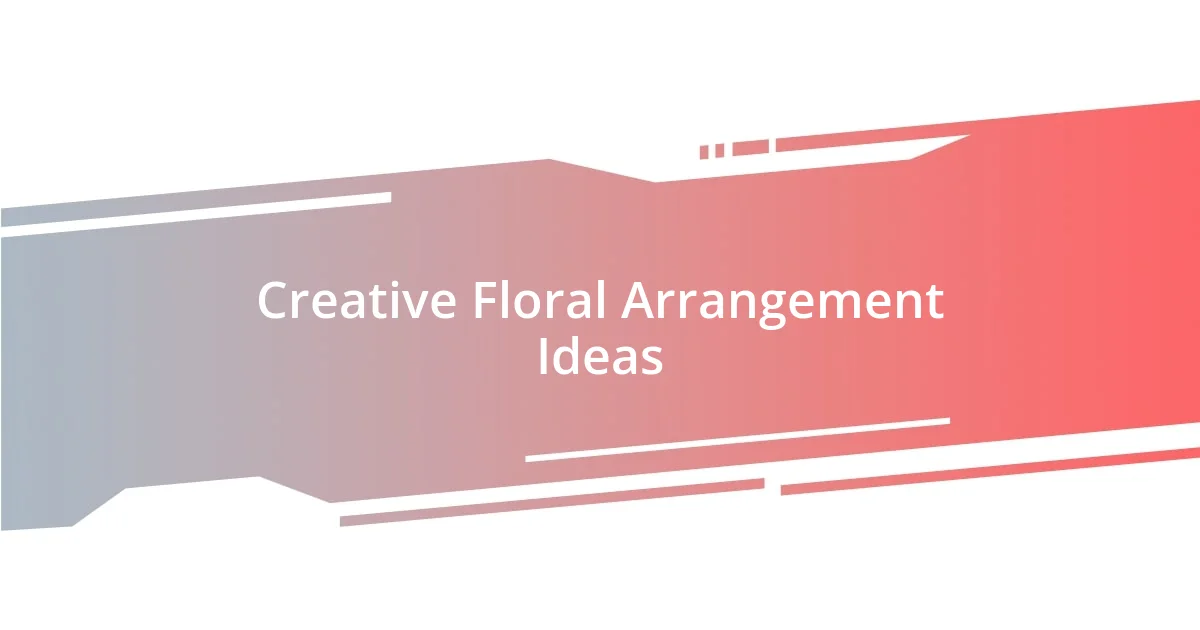
Creative Floral Arrangement Ideas

Creative Floral Arrangement Ideas
One idea I love is to think outside the traditional vase. I once used an antique teacup for a delicate arrangement featuring white daisies and soft lavender. The unexpected container brought a charming element to the display that caught everyone’s eye. Have you ever considered how the vessel can play as much of a role as the flowers themselves? A unique container can set the whole mood of your arrangement, inviting admiration and conversation.
Another approach is to create a cohesive theme by incorporating natural elements alongside your blooms. I remember a summer workshop where we gathered pinecones, seashells, and dried leaves to mix with vibrant flowers like sunflowers and zinnias. It transformed the entire composition into a mini landscape! Don’t be afraid to delve into your surroundings. What little treasures from nature could you include to give your arrangements a personal touch?
For a more contemporary look, try using monochromatic palettes. I once crafted an all-white arrangement using calla lilies, white roses, and even white feathers. The result was striking and elegant, not to mention surprisingly soothing. Have you experimented with color schemes in your arrangements? Playing with different shades creates a sense of harmony and can evoke specific emotions, enhancing your floral storytelling. Embrace your creative instincts and see how new ideas can breathe life into your floral designs!


